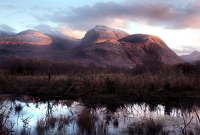
The highest peak on the British Isles, Ben Nevis, affectionately known as 'The Ben' among locals, is an extremely popular destination for serious mountaineers and intrepid hikers alike. Located near the charming town of Fort William in the Scottish Highlands, the imposing igneous cliffs of Ben Nevis dominate the skyline and offer an irresistible challenge to active types looking to conquer Britain's most intimidating climb. The cliffs of the mountain are ideal for climbers and are also one of the UK's best ice climbing sites. There are two main routes up the mountain: the Mountain Track, which is geared for experienced climbers, and features a thrilling ascent up craggy 700 metre (2,300 feet) cliffs on the mountain's north face; and the gentler Glen Nevis route, which is suited to fit hikers, and follows a steep track up the mountain's south face. On the summit of Ben Nevis, the ruins of an old observatory (abandoned since 1904) can be found, and the views are immense, rugged and spectacular. At the foot of the mountain, the famous and popular Ben Nevis Distillery can be found near Victoria Bridge (a little ways north of Fort William), providing an interesting excursion for malt whisky enthusiasts.
Address : Scottish Highlands, near Fort William
Website : www.ben-nevis.com
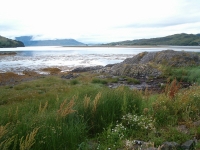
Sitting on the shores of Loch Linnhe, Fort William is the gateway to some of the Highlands' finest natural attractions and is a natural stop-off for those heading up to the north of Scotland. Ben Nevis is just to the south of the town and at 4406ft (1,344m) is Britain's highest mountain. It is a very popular challenge for walkers, but should not be taken lightly. Although the mountain is not massive by international standards, the walk starts near sea level.Climbers should also be prepared for the unpredictable Scottish weather that can quickly turn to sub-arctic temperatures at any time of year. The striking scenery of Aviemore, Cairngorm and Glencoe is nearby; in winter, the area opens for skiing for those happy to brave the regular blizzards. Fort William is also a good starting point for the West Highland Way, a footpath that runs along the West coast down to Glasgow. Another outdoor activity popular in the region is mountain biking, and there are some renowned downhill tracks near Fort William.As the name suggests, Fort William also has a rather tumultuous military history.The town is now a peaceful summer holiday retreat that offers a selection of hotels, cafes, shops and restaurants.
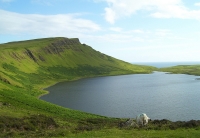
Linked to the mainland by the Skye Bridge in 1995, the Isle of Skye is the most scenic and easily accessible of Scotland's many islands and attracts thousands of visitors on holiday each year. The weather is unpredictable, but when the sun shines there are few more beautiful places in Europe. It is an island of rough textures, soft colours and fine light that whispers of romance and escape.It was from the Isle of Skye that Flora Macdonald helped Bonne Prince Charlie escape to France and it is said that they had a short relationship. There is a display on the escape at the Skye Museum of Island Life, and Flora Macdonald's grave lies nearby. Towards the west of the island is Dunvegan Castle, home to the chiefs of MacLeod for over 700 years, and the Isle of Skye's most famous historical landmark. It has some fascinating exhibits, lovely gardens and a restaurant. Despite a rich and cruel history, which includes Viking invasions and bitter clan feuds, the Isle of Skye has retained its strong traditions and has a thriving Gaelic culture; the majority of the population still speak Gaelic as their first language. The Isle of Skye lies on the northwest coast of Scotland, about 250 miles (402km) by car from Edinburgh.
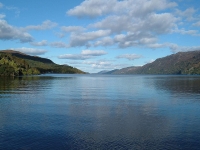
Loch Ness is situated in the Great Glen that links Inverness on the east coast to Fort William in the west. The most famous lake is 24 miles (39km) long, half a mile (1km) wide and 700ft (213m) deep and is home to the legendary Loch Ness Monster (affectionately called Nessie), which many claim to have glimpsed from the shore, despite the ongoing scepticism of scientists. There are fine walks around the mountains and glens that surround the loch and many head for the scenic ruins of Urquhart Castle or the Nessie exhibition at Drumnadrochit.The four lochs that make up the Great Glen are linked by the Caledonian Canal, which was built in the early 1800s to enable ships to pass from the North Sea to the Atlantic without having to navigate Scotland's harsh north coast. The most traditional and comfortable way to travel along the glen is by boat, and a flotilla of canoes, yachts and cruising boats are available for hire in Inverness and Fort William. The more energetic may opt to walk or cycle along the 70-mile (113km) Great Glen Way. The walk will take four to seven days. Whether for the enticing mystery of the monster or the stunning natural beauty of the area, travellers relish a visit to Loch Ness.
Website : www.loch-ness.org
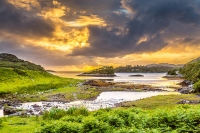
Beyond Inverness and the Great Glen, Scotland stretches away in a spectacular fusion of wooded glens, sweeping moors, rugged coasts, towering mountains and welcoming villages. The Northern Highlands includes both the rich farmland of the Black Isle and the precipitous sea cliffs of Cape Wrath. The traditional crofting communities of North West Sutherland, the busy towns of Easter Ross, the historic fishing villages of Caithness, the wooded hills of Mid Ross, the popular beaches of East Sutherland and the majestic mountains of Wester Ross are all contained in the Northern Highlands.Due to its remoteness, this huge area is largely overlooked by tourists despite having some of the most dramatic landscapes in all of Europe. The Northern Highlands are a paradise for those seeking out solitude and active outdoor pursuits in breath-taking landscapes. There are ancient archaeological sites and a number of quality heritage centres around Caithness and along the northern coast, dealing with the rich clan history and Viking heritage of the region. The Northern Highlands seem designed for walkers and hikers and the patchwork of beautiful lochs in the northwest attract fishermen. Golf, cycling and water-sports are also popular activities, with a number of great boat trips exploring the rugged coastline.
Website : www.visithighlands.com/northern-scottish-highlands/

Travel Guide powered by Word Travels, copyright © 2023 Globe Media Ltd. By its very nature information in this travel guide is subject to change at short notice and travellers are urged to verify information on which they're relying with the relevant authorities. Neither Globe Media Ltd nor Travel Vogue can accept any responsibility for any loss or inconvenience to any person as a result of information contained above.